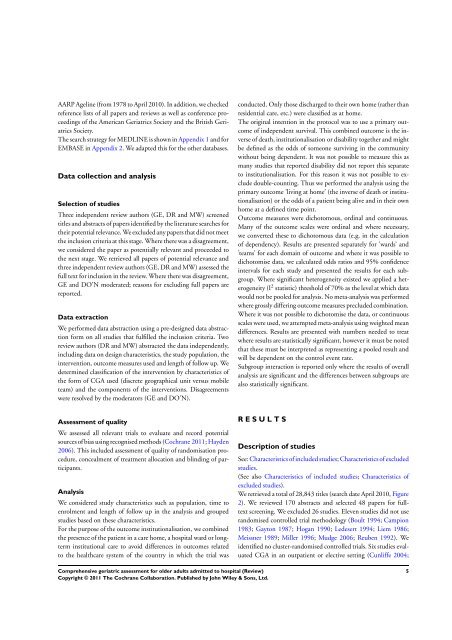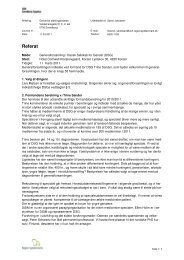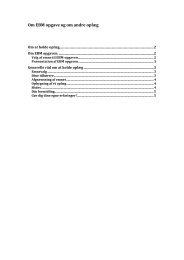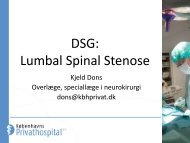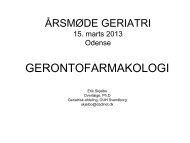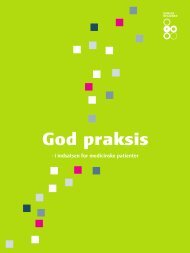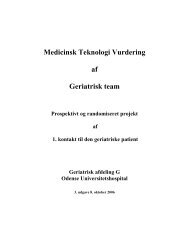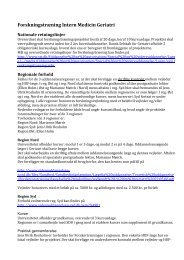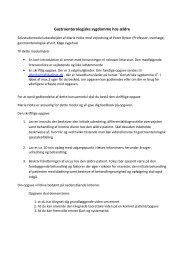Comprehensive geriatric assessment for older adults admitted to ...
Comprehensive geriatric assessment for older adults admitted to ...
Comprehensive geriatric assessment for older adults admitted to ...
Create successful ePaper yourself
Turn your PDF publications into a flip-book with our unique Google optimized e-Paper software.
AARP Ageline (from 1978 <strong>to</strong> April 2010). In addition, we checked<br />
reference lists of all papers and reviews as well as conference proceedings<br />
of the American Geriatrics Society and the British Geriatrics<br />
Society.<br />
The search strategy <strong>for</strong> MEDLINE is shown in Appendix 1 and <strong>for</strong><br />
EMBASE in Appendix 2. We adapted this <strong>for</strong> the other databases.<br />
Data collection and analysis<br />
Selection of studies<br />
Three independent review authors (GE, DR and MW) screened<br />
titles and abstracts of papers identified by the literature searches <strong>for</strong><br />
their potential relevance. We excluded any papers that did not meet<br />
the inclusion criteria at this stage. Where there was a disagreement,<br />
we considered the paper as potentially relevant and proceeded <strong>to</strong><br />
the next stage. We retrieved all papers of potential relevance and<br />
three independent review authors (GE, DR and MW) assessed the<br />
full text <strong>for</strong> inclusion in the review. Where there was disagreement,<br />
GE and DO’N moderated; reasons <strong>for</strong> excluding full papers are<br />
reported.<br />
Data extraction<br />
We per<strong>for</strong>med data abstraction using a pre-designed data abstraction<br />
<strong>for</strong>m on all studies that fulfilled the inclusion criteria. Two<br />
review authors (DR and MW) abstracted the data independently,<br />
including data on design characteristics, the study population, the<br />
intervention, outcome measures used and length of follow up. We<br />
determined classification of the intervention by characteristics of<br />
the <strong>for</strong>m of CGA used (discrete geographical unit versus mobile<br />
team) and the components of the interventions. Disagreements<br />
were resolved by the modera<strong>to</strong>rs (GE and DO’N).<br />
Assessment of quality<br />
We assessed all relevant trials <strong>to</strong> evaluate and record potential<br />
sources of bias using recognised methods (Cochrane 2011; Hayden<br />
2006). This included <strong>assessment</strong> of quality of randomisation procedure,<br />
concealment of treatment allocation and blinding of participants.<br />
Analysis<br />
We considered study characteristics such as population, time <strong>to</strong><br />
enrolment and length of follow up in the analysis and grouped<br />
studies based on these characteristics.<br />
For the purpose of the outcome institutionalisation, we combined<br />
the presence of the patient in a care home, a hospital ward or longterm<br />
institutional care <strong>to</strong> avoid differences in outcomes related<br />
<strong>to</strong> the healthcare system of the country in which the trial was<br />
conducted. Only those discharged <strong>to</strong> their own home (rather than<br />
residential care, etc.) were classified as at home.<br />
The original intention in the pro<strong>to</strong>col was <strong>to</strong> use a primary outcome<br />
of independent survival. This combined outcome is the inverse<br />
of death, institutionalisation or disability <strong>to</strong>gether and might<br />
be defined as the odds of someone surviving in the community<br />
without being dependent. It was not possible <strong>to</strong> measure this as<br />
many studies that reported disability did not report this separate<br />
<strong>to</strong> institutionalisation. For this reason it was not possible <strong>to</strong> exclude<br />
double-counting. Thus we per<strong>for</strong>med the analysis using the<br />
primary outcome ’living at home’ (the inverse of death or institutionalisation)<br />
or the odds of a patient being alive and in their own<br />
home at a defined time point.<br />
Outcome measures were dicho<strong>to</strong>mous, ordinal and continuous.<br />
Many of the outcome scales were ordinal and where necessary,<br />
we converted these <strong>to</strong> dicho<strong>to</strong>mous data (e.g. in the calculation<br />
of dependency). Results are presented separately <strong>for</strong> ’wards’ and<br />
’teams’ <strong>for</strong> each domain of outcome and where it was possible <strong>to</strong><br />
dicho<strong>to</strong>mise data, we calculated odds ratios and 95% confidence<br />
intervals <strong>for</strong> each study and presented the results <strong>for</strong> each subgroup.<br />
Where significant heterogeneity existed we applied a heterogeneity<br />
(I 2 statistic) threshold of 70% as the level at which data<br />
would not be pooled <strong>for</strong> analysis. No meta-analysis was per<strong>for</strong>med<br />
where grossly differing outcome measures precluded combination.<br />
Where it was not possible <strong>to</strong> dicho<strong>to</strong>mise the data, or continuous<br />
scales were used, we attempted meta-analysis using weighted mean<br />
differences. Results are presented with numbers needed <strong>to</strong> treat<br />
where results are statistically significant, however it must be noted<br />
that these must be interpreted as representing a pooled result and<br />
will be dependent on the control event rate.<br />
Subgroup interaction is reported only where the results of overall<br />
analysis are significant and the differences between subgroups are<br />
also statistically significant.<br />
R E S U L T S<br />
<strong>Comprehensive</strong> <strong>geriatric</strong> <strong>assessment</strong> <strong>for</strong> <strong>older</strong> <strong>adults</strong> <strong>admitted</strong> <strong>to</strong> hospital (Review)<br />
Copyright © 2011 The Cochrane Collaboration. Published by John Wiley & Sons, Ltd.<br />
Description of studies<br />
See: Characteristics of included studies; Characteristics of excluded<br />
studies.<br />
(See also Characteristics of included studies; Characteristics of<br />
excluded studies).<br />
We retrieved a <strong>to</strong>tal of 28,843 titles (search date April 2010, Figure<br />
2). We reviewed 170 abstracts and selected 48 papers <strong>for</strong> fulltext<br />
screening. We excluded 26 studies. Eleven studies did not use<br />
randomised controlled trial methodology (Boult 1994; Campion<br />
1983; Gay<strong>to</strong>n 1987; Hogan 1990; Ledesert 1994; Liem 1986;<br />
Meissner 1989; Miller 1996; Mudge 2006; Reuben 1992). We<br />
identified no cluster-randomised controlled trials. Six studies evaluated<br />
CGA in an outpatient or elective setting (Cunliffe 2004;<br />
5


